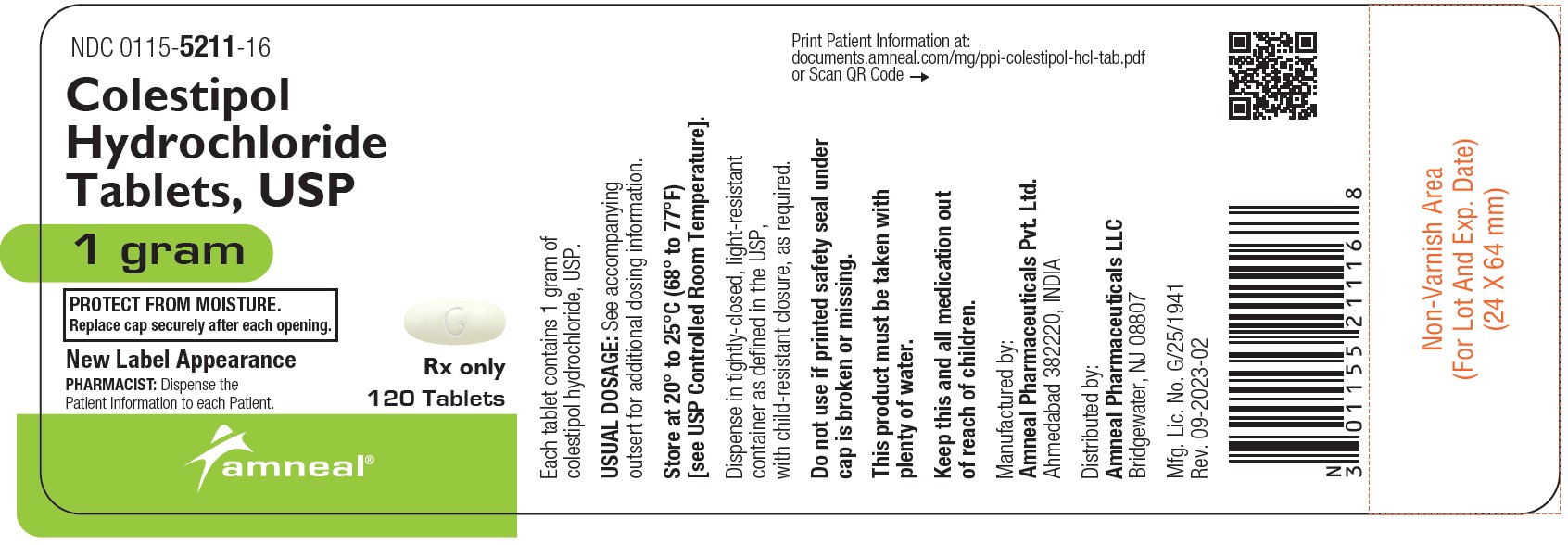Drug Catalog - Product Detail
COLESTIPOL HCL TB 1GM 120
| NDC | Mfr | Size | Str | Form |
|---|---|---|---|---|
| 00115-5211-16 | AMNEAL PHARMACEUTICALS | 120 | 1GM | TABLET |
PACKAGE FILES


Generic Name
COLESTIPOL HYDROCHLORIDE
Substance Name
COLESTIPOL HYDROCHLORIDE
Product Type
HUMAN PRESCRIPTION DRUG
Route
ORAL
Application Number
ANDA077510
Description
DESCRIPTION The active ingredient in colestipol hydrochloride tablets, USP is colestipol hydrochloride USP, which is a lipid lowering agent for oral use. Colestipol is an insoluble, high molecular weight basic anion-exchange copolymer of diethylenetriamine and 1-chloro-2, 3-epoxypropane, with approximately 1 out of 5 amine nitrogens protonated (chloride form). It is a light yellow water-insoluble resin which is hygroscopic and swells when suspended in water or aqueous fluids. Each colestipol hydrochloride tablet, USP contains one gram of colestipol hydrochloride USP. Colestipol hydrochloride tablets are off-white to pale-yellow in color and are tasteless and odorless. The inactive ingredients are cellulose acetate phthalate, colloidal silicon dioxide, copovidone, dibutyl sebacate, hypromellose type 2910, microcrystalline cellulose and polyethylene glycol 6000.
How Supplied
HOW SUPPLIED Colestipol Hydrochloride Tablets USP, 1 gram are off-white to pale-yellow, film-coated, oval tablets, debossed with "G" on one side and plain on the other. They are available as follows: Bottles of 120: NDC 0115-5211-16 Bottles of 500: NDC 0115-5211-02 Each tablet contains 1 gram of colestipol hydrochloride, USP. Store at 20° to 25°C (68° to 77°F) [see USP Controlled Room Temperature]. Protect from moisture.
Indications & Usage
INDICATIONS AND USAGE Since no drug is innocuous, strict attention should be paid to the indications and contraindications, particularly when selecting drugs for chronic long-term use. Colestipol hydrochloride tablets are indicated as adjunctive therapy to diet for the reduction of elevated serum total and LDL-C in patients with primary hypercholesterolemia (elevated LDL-C) who do not respond adequately to diet. Generally, colestipol hydrochloride tablets have no clinically significant effect on serum triglycerides, but with their use, triglyceride levels may be raised in some patients. Therapy with lipid-altering agents should be a component of multiple risk factor intervention in those individuals at significantly increased risk for atherosclerotic vascular disease due to hypercholesterolemia. Treatment should begin and continue with dietary therapy (see NCEP guidelines). A minimum of six months of intensive dietary therapy and counseling should be carried out prior to initiation of drug therapy. Shorter periods may be considered in patients with severe elevations of LDL-C or with definite CHD. According to the NCEP guidelines, the goal of treatment is to lower LDL-C, and LDL-C is to be used to initiate and assess treatment response. Only if LDL-C levels are not available, should the Total-C be used to monitor therapy. The NCEP treatment guidelines are shown below. LDL-Cholesterol mg/dL (mmol/L) Definite Atherosclerotic Disease * Two or More Other Risk Factors † Initiation Level Goal No No ≥ 190 (≥ 4.9) < 160 (< 4.1) No Yes ≥ 160 (≥ 4.1) < 130 (< 3.4) Yes Yes or No ≥ 130 (≥ 3.4) ≤ 100 (≤ 2.6) * Coronary heart disease or peripheral vascular disease (including symptomatic carotid artery disease). † Other risk factors for coronary heart disease (CHD) include: age (males: ≥ 45 years; female: ≥ 55 years or premature menopause without estrogen replacement therapy); family history of premature CHD; current cigarette smoking; hypertension; confirmed HDL-C <35 mg/dL (0.91 mmol/L); and diabetes mellitus. Subtract one risk factor if HDL-C is ≥ 60 mg/dL (1.6 mmol/L).
Dosage and Administration
DOSAGE AND ADMINISTRATION For adults, colestipol hydrochloride tablets are recommended in doses of 2 to 16 grams/day given once or in divided doses. The starting dose should be 2 grams once or twice daily. Dosage increases of 2 grams, once or twice daily should occur at 1- or 2-month intervals. Appropriate use of lipid profiles as per NCEP guidelines including LDL-C and triglycerides, is advised so that optimal but not excessive doses are used to obtain the desired therapeutic effect on LDL-C level. If the desired therapeutic effect is not obtained at a dose of 2 to 16 grams/day with good compliance and acceptable side effects, combined therapy or alternate treatment should be considered. Colestipol hydrochloride tablets must be taken one at a time and be promptly swallowed whole, using plenty of water or other appropriate liquid. Do not cut, crush, or chew the tablets. Patients should take other drugs at least one hour before or four hours after colestipol hydrochloride tablets to minimize possible interference with their absorption (see Drug Interactions ). Before Administration of Colestipol Hydrochloride Tablets 1. Define the type of hyperlipoproteinemia, as described in NCEP guidelines. 2. Institute a trial of diet and weight reduction. 3. Establish baseline serum total and LDL-C and triglyceride levels. During Administration of Colestipol Hydrochloride Tablets 1. The patient should be carefully monitored clinically, including serum cholesterol and triglyceride levels. Periodic determinations of serum cholesterol levels as outlined in the NCEP guidelines should be done to confirm a favorable initial and long-term response. 2. Failure of total or LDL-C to fall within the desired range should lead one to first examine dietary and drug compliance. If these are deemed acceptable, combined therapy or alternate treatment should be considered. 3. Significant rise in triglyceride level should be considered as indication for dose reduction, drug discontinuation, or combined or alternate therapy.
